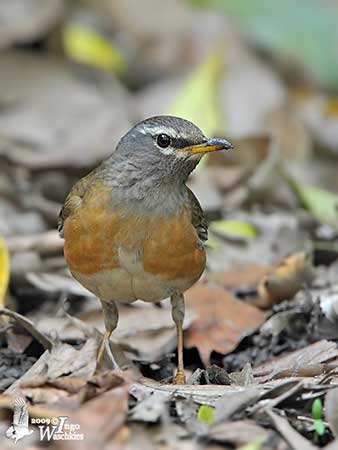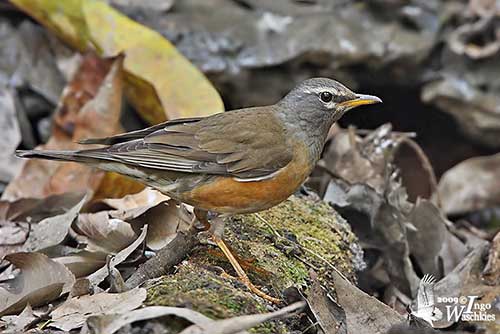
Fr: Merle obscur – Grive obscure
Ang: Eyebrowed Thrush
All: Weißbrauendrossel
Esp: Zorzal Rojigrís
Ita: Tordo oscuro
Nd: Vale Lijster
Sd: gråhalsad trast
Photographer:
Ingo Waschkies
Bird Photography
Text by Nicole Bouglouan
Sources:
HANDBOOK OF THE BIRDS OF THE WORLD Vol 10 by Josep del Hoyo-Andrew Elliott-David Christie - Lynx Edicions - ISBN: 8487334725
THRUSHES by Peter Clement and Ren Hathway – HELM - ISBN: 0713639407
A Field Guide to the Birds of South-East Asia by Craig Robson. New Holland Publishers. ISBN: 9781780090498
BIRDS OF THE MIDDLE EAST by R.F. Porter, S. Christensen, P Schiermacker-Ansen C.Helm - ISBN: 0713670169
South Dakota Birds and Birding – (Terry L. Sohl)
What Bird-The ultimate Bird Guide (Mitchell Waite)
Eyebrowed Thrush
Turdus obscurus
Passeriformes Order – Turdidae Family
INTRODUCTION:
The Eyebrowed Thrush is a medium-sized Turdidae with conspicuous head pattern. It occurs in C and E Siberia and NE China, and migrates from south to SE Asia and Indonesia. It regularly visits the W Aleutian Islands in spring.
It frequents dense coniferous forests and taiga during the breeding season, but it occurs in a variety of wooded habitats in winter. It typically feeds on insects, snails, earthworms, fruits and berries taken both in trees and on the ground. Two broods are usually produced during the breeding season.
The Eyebrowed Thrush is described as fairly common to common throughout its large range.
DESCRIPTION OF THE BIRD:
Biometrics:
Length: 21-23 cm
Weight: 61-117 g
The Eyebrowed Thrush adult male has mostly deep brown upperparts on mantle, back and scapulars, whereas lower back, rump and uppertail-coverts show rufous-brown wash. The tail is dark brown.
On the upperwing, alula and primary coverts are darker brown with pale buff edges. The flight-feathers are dark brown with paler outer edges to secondaries and tertials.
On the underparts, breast and flanks may vary from buff-brown to orange-rufous. Centre of lower breast, belly, vent and undertail-coverts are whitish. On the underwing, the coverts are pale greyish-brown with olive tinge.

On the head, forehead, crown and nape are grey with brownish tinge. Lores are black, like a small area behind the eye. The supercilium, a short submoustachial streak and the chin are whitish. Rest of head and neck are grey.
The bill is brownish, with yellow lower mandible. The eyes are dark brown. Legs and feet vary from yellowish-brown to flesh-brown.
Male and female have similar appearance, although the female has browner head and more white on sides of neck and throat. The underparts are duller.
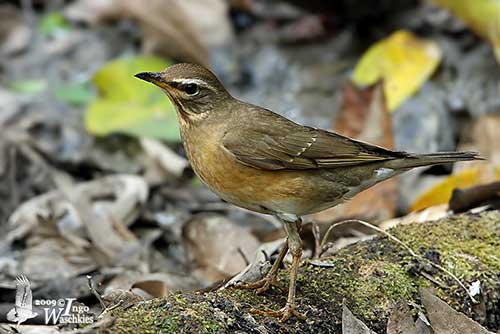
The juvenile is duller than adults, with indistinct dark and pale markings on the head, buff markings on the upperparts and dark spotting on the underparts.
DISTRIBUTION GEOGRAPHIQUE:
The Eyebrowed Thrush breeds in central and eastern Siberia, E to Kamchatka, and S to N Mongolia, Amurland and Sakhalin.
It winters in NE Indian Subcontinent E to Taiwan, S to Greater Sundas and Philippines.
HABITAT:
The Eyebrowed Thrush breeds in dense coniferous forests (spruce and fir) and taiga. It often breeds near water, in valleys and slopes covered with Pinus forests with dense canopy, in mixed forests and woods, both in lowlands and mountains, from sea-level up to 1,500 metres of elevation.
On migration and in winter, it frequents the edges of cultivated areas, orchards, parks and large gardens with trees. It may reach 2,300 to 3,300 metres of elevation in Borneo.
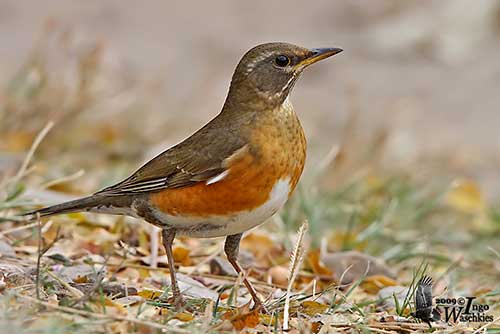
CALLS AND SONGS: SOUNDS BY XENO-CANTO
The Eyebrowed Thrush gives thin “sip-sip” or longer “ziii” and chuckling “tuck-tuck” or “tchuck” as contact calls. In flight, it utters a thin “zieeh” or harsher “tseee”.
The song includes 2-3 mournful phrases “teveteu trrryutetyute trrryutetyutyu…” usually followed by lower twittering and discordant warbling alternating with short pauses.
BEHAVIOUR IN THE WILD:
The Eyebrowed Thrush feeds typically on insects, earthworms, snails, berries and fruits. It forages both in trees and on the ground. Berries and fruits are gleaned from branches and tree foliage, whereas on the ground, it hops and runs, stopping to check and to pick up food, usually invertebrates.
This species may occur alone or in pairs, and mostly in groups on migration and in winter.
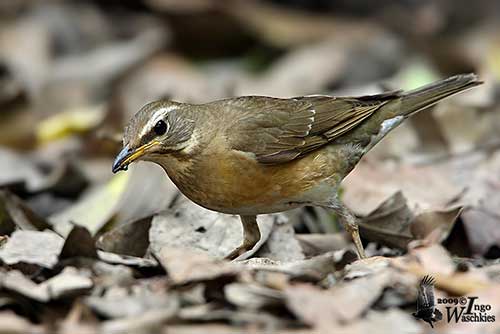
Information on courtship behaviour is currently lacking. This species nests in trees and the female incubates alone.
The Eyebrowed Thrush is migratory and the post-breeding dispersal of adults and immatures in C Siberia starts in mid-July, but southwards movements occur mainly in mid-August and the breeding areas are deserted by early September. They arrive in NE India in late October/early November, whereas the birds wintering in S Malaysia and N Borneo arrive from mid-November to mid-December.
The return movements take place in spring, with the breeding birds arriving in E Siberia from mid-May, and on Kamchatka in late May/early June.
Vagrants are recorded in Europe, Morocco, Middle East, and regularly in NW USA in Alaska, and Pribilof Islands and Aleutian Islands.
The Eyebrowed Thrush performs a swift, strong, direct flight with rapid wingbeats.
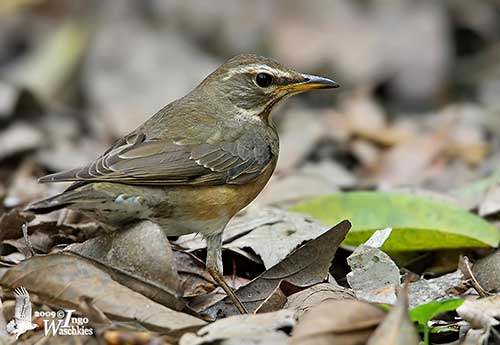
REPRODUCTION OF THIS SPECIES:
The breeding season occurs between late May and late July.
The Eyebrowed Thrush builds a large, cup-shaped structure with rootlets, grass, sticks, moss, bark and larch’s needles. The cup is lined with grass and mud. It is placed in tree fork or in bush, up to 9 metres above the ground.
The female lays 5-6 pale grey to blue-green eggs with dark markings. The female incubates alone during 13-15 days. The chicks are fed by both parents, and fledge about 10-12 days after hatching.
PROTECTION / THREATS / STATUS:
The Eyebrowed Thrush is usually common to fairly common throughout its large range. The impact of modification and degradation of the habitat are unknown, and the population size has not been quantified.
However, the Eyebrowed Thrush does not appear threatened and is currently evaluated as Least Concern.
